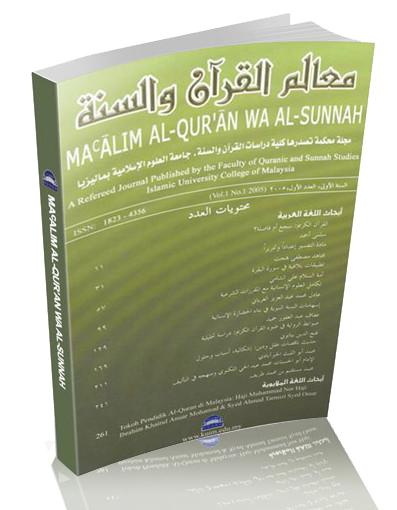Keperluan Penyeragaman Gaya Penulisan Takhrij Bagi Penulisan Ilmiah: Satu Cadangan
The Need for Standardization of Style of Writing Takhrij Al-Hadith for Academic: A Suggestion
DOI:
https://doi.org/10.33102/jmqs.v14i1.117Keywords:
takhrij, style, standardization. academic writing, hadithAbstract
Takhrij has been defined as disclosing the original source of a hadith from the major books of Islam and revealing its status if it needed. The main purpose of it is to preserve the hadith of the Prophet SAW from being falsified as well as to rectified the facts related to it. Proper writing of takhrij hadith has become a common requirement stressed from many parties. Many writings, especially scientific, have required that each hadith that been exposed must disclose its takhrij properly. Although it has been stressed, many inconsistency styles of writing found in the documentation of takhrij. The inconsistencies have confused some reader to the excact meaning of the documentation. The absence of a proper guide to the way of writing of takhrij is been found one of the reason of the inconsistencies. This article aims to discuss the inconsistencies and proposes a few suggestions of stlye of documentation of takhrij to be applied in scientific writing.
References
A. Irwan Santeri Doll Kawaid et al. (2012). Inovasi Dalam Pengajaran Hadis: Penggunaan Laman Web Islamweb.net dalam Pengkajian Sanad. Bangi. Darul Syakir.
Abu Syuhbah, Muhammad Bin Muhammad. (1983). Al-Wasit Fi Ulum wa Mustalah Al-Hadith. Dar Al-Fikr Al-Arabi
Faisal Ahmad Shah. (2017). Garis Panduan Sumber Rujukan & Hukum Hadith. Kuala Lumpur: Jabatan al-Quran & al-Hadith,
Grange, Bob, and D. A. Bloom. (2000). Acronyms, abbreviations and initialisms. BJU international 86, no. 1 1-6.
Muhammad Abu al-Layth al-Khayr Abad'i. (2004). “Takhrij al-Hadith: Nasy'atuhu wa Manhajiyyatuhu.” Deoband: Ittihad Book.
Najm Abdulrahman Khalaf dan Sajedah Hilmi Samarah. (2014). al-Wajiz fi `Ilm al-Takhrij, Bangi: Darul Syakir Enterprise.
Al-Tahhan, Mahmud. (1978). "Usul al-Takhrij wa Dirasah al-Asanid." Beirut: Dar al-Qur‟ an al-Karim.
Topu, Fatma Burcu, and Yuksel Goktas. (2012). ICT Teachers' Assigned Roles and Expectations from Them. Educational Sciences: Theory and Practice 12, no. 1. 473-478.
Muhammad Mahmud Bakkar. (1997). Ilm Takhrij al-Ahadith: Usuluhu, Taraiquhu, Manahijuhu. Riyadh: Dar Taybah.
Ma al-Farq Bayna al-Ikhraj wa al-Takhrij wa al-Istikhraj? http://www.3refe.com
Downloads
Published
How to Cite
Issue
Section
License
Copyright (c) 2018 A. Irwan Santeri Doll Kawaid, Zulhilmi Mohamed Nor, Amiruddin Mohd Sobali, Mohd Zohdi Mohd Amin

This work is licensed under a Creative Commons Attribution 4.0 International License.
The copyright of this article will be vested to author(s) and granted the journal right of first publication with the work simultaneously licensed under the Creative Commons Attribution 4.0 International (CC BY 4.0) license, unless otherwise stated.
Authors are able to enter into separate, additional contractual arrangements for the non-exclusive distribution of the journal's published version of the work (e.g., post it to an institutional repository or publish it in a book), with an acknowledgement of its initial publication in this journal.
Authors are permitted and encouraged to post their work online (e.g., in institutional repositories or on their website) prior to and during the submission process, as it can lead to productive exchanges, as well as earlier and greater citation of published work.









